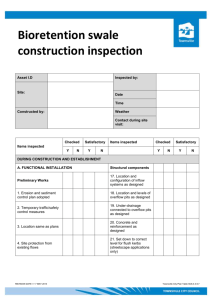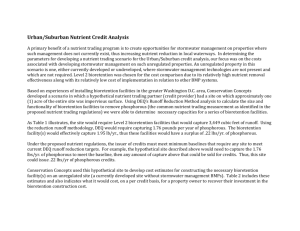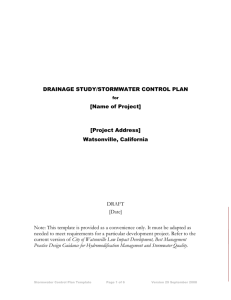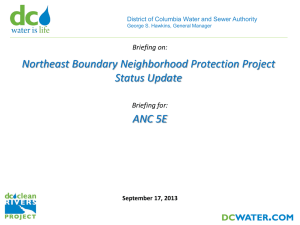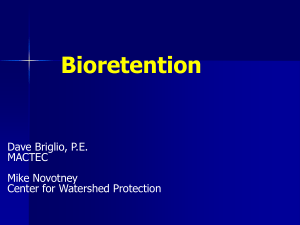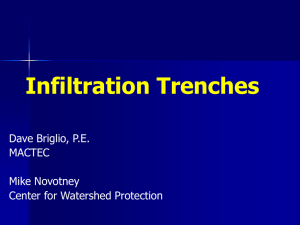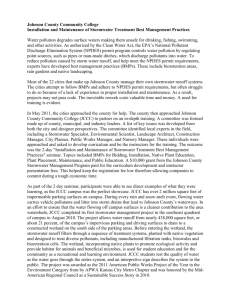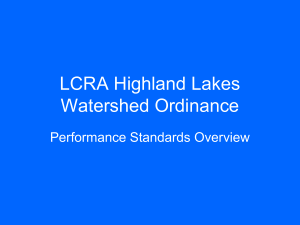Proposal to Deep Root from Kestrel Design
advertisement
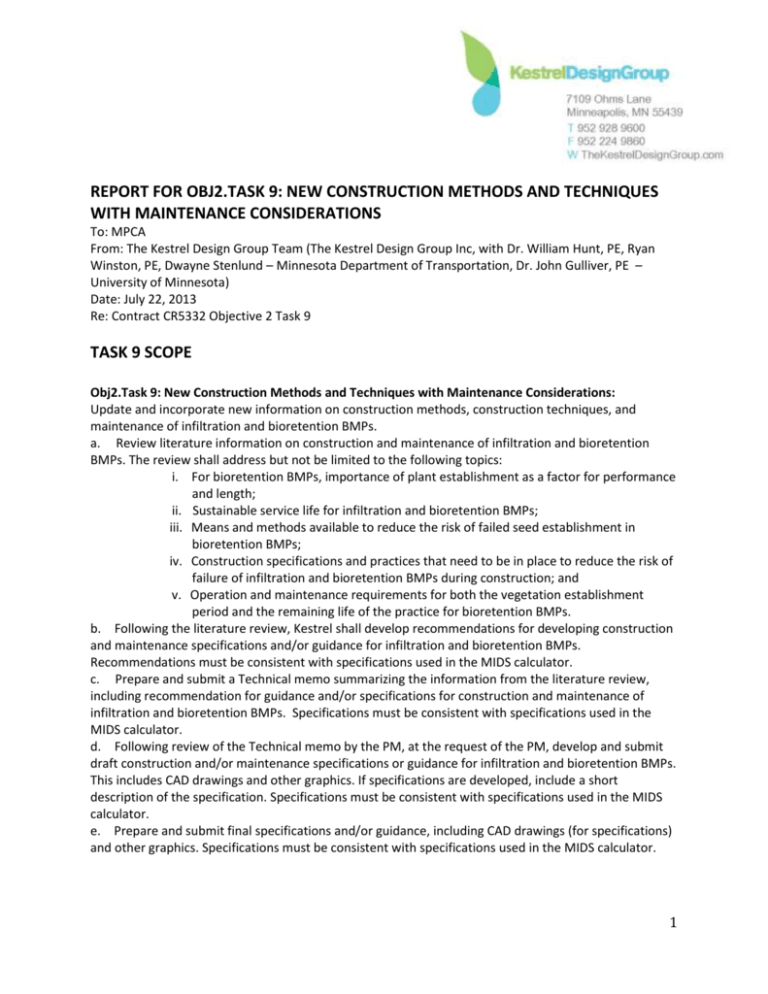
REPORT FOR OBJ2.TASK 9: NEW CONSTRUCTION METHODS AND TECHNIQUES WITH MAINTENANCE CONSIDERATIONS To: MPCA From: The Kestrel Design Group Team (The Kestrel Design Group Inc, with Dr. William Hunt, PE, Ryan Winston, PE, Dwayne Stenlund – Minnesota Department of Transportation, Dr. John Gulliver, PE – University of Minnesota) Date: July 22, 2013 Re: Contract CR5332 Objective 2 Task 9 TASK 9 SCOPE Obj2.Task 9: New Construction Methods and Techniques with Maintenance Considerations: Update and incorporate new information on construction methods, construction techniques, and maintenance of infiltration and bioretention BMPs. a. Review literature information on construction and maintenance of infiltration and bioretention BMPs. The review shall address but not be limited to the following topics: i. For bioretention BMPs, importance of plant establishment as a factor for performance and length; ii. Sustainable service life for infiltration and bioretention BMPs; iii. Means and methods available to reduce the risk of failed seed establishment in bioretention BMPs; iv. Construction specifications and practices that need to be in place to reduce the risk of failure of infiltration and bioretention BMPs during construction; and v. Operation and maintenance requirements for both the vegetation establishment period and the remaining life of the practice for bioretention BMPs. b. Following the literature review, Kestrel shall develop recommendations for developing construction and maintenance specifications and/or guidance for infiltration and bioretention BMPs. Recommendations must be consistent with specifications used in the MIDS calculator. c. Prepare and submit a Technical memo summarizing the information from the literature review, including recommendation for guidance and/or specifications for construction and maintenance of infiltration and bioretention BMPs. Specifications must be consistent with specifications used in the MIDS calculator. d. Following review of the Technical memo by the PM, at the request of the PM, develop and submit draft construction and/or maintenance specifications or guidance for infiltration and bioretention BMPs. This includes CAD drawings and other graphics. If specifications are developed, include a short description of the specification. Specifications must be consistent with specifications used in the MIDS calculator. e. Prepare and submit final specifications and/or guidance, including CAD drawings (for specifications) and other graphics. Specifications must be consistent with specifications used in the MIDS calculator. 1 LIST of FIGURES Figure 1. Demonstration of the rake technique with a bucket with teeth (left) and scoop technique using a bucket with a smooth blade (right). REPORT i. FOR BIORETENTION BMPS, IMPORTANCE OF PLANT ESTABLISHMENT AS A FACTOR FOR PERFORMANCE AND LENGTH; Vigorous plants are crucial to the bioretention system’s long term stormwater performance. Plant roots help soil particles form stable aggregates, improve soil structure, maintain and increase water storage and infiltration capacity, as well as improve stormwater pollutant removal. Specific stormwater benefits are detailed below. 1. Interception and Evapotranspiration Two stormwater treatment mechanisms that are absent without plants are plant interception and evapotranspiration. Woody vegetation typically intercepts and evapotranspires significantly more water than herbaceous vegetation, and large trees intercept and evapotranspire significantly more rain than small trees. For example, a healthy 40 year old Hackberry tree in the Midwest is estimated to provide 14 times as much interception as a 10 year old Hackberry (McPherson et al 2006). Factors that affect magnitude of interception and evapotranspiration, (e.g.. leaf area index, canopy size, and climate), will be detailed in the interception and evapotranspiration literature review for Task 13 of Objective 1. 2. Crucial to Long Term Infiltration As plant roots grow and then decay, they restore and/or enhance soil porosity and infiltration rates. Several studies that have compared bioretention with plants to bioretention without plants have found a significant increase in saturated hydraulic conductivity with plants vs. without plants (e.g. Lucas and Greenway 2011a). Deeper rooted plants yield higher infiltration rates than shallow rooted plants. Plant roots have even been shown to be able to penetrating confining layers (prairie plant roots in Selbig and Balster 2010, tree roots in Bartens et al 2008). 2 In a 5 year study, two side by side raingardens, one with native prairie plants, and one planted with turf grasses, were compared at each of 2 sites, one in sand soils and one in clay soils (Selbig and Balster 2010). Researchers found: Within each soil type, rain gardens with prairie vegetation had greater median infiltration rates than those with turf grass. Roots in the prairie clay garden were significantly deeper than in the one with turf: 4.7 ft in the prairie garden vs. 0.46 ft in the turf clay garden. Roots in the prairie clay garden were able to penetrate a confining layer at a 3 ft depth. The prairie-clay raingarden showed greater biological activity of flora and fauna than the turfclay raingarden. An observation trench excavated in each clay raingarden after 5 years showed that the prairie raingarden was well drained, while the turf raingarden showed clear evidence of a perched water table. The turf clay raingarden had a strongly gleyed horizon from 1.05 to 2.95 ft, indicative of an anaerobic, saturated soil. Oxidized mottles and other redox features in the turf clay garden B horizon further indicated a fluctuating perched water table . 3. Crucial to Water Quality Benefits Studies have also found that vegetation is crucial to many water quality benefits, including removal of dissolved nutrients, hydrocarbons, and TSS. 1) Plants improve dissolved nutrient removal Studies that have compared bioretention systems without plants to planted bioretention systems have found that plants significantly improve dissolved nutrient removal of bioretention systems (Henderson 2009, Lucas and Greenway 2008, Lucas and Greenway 2011a, Denman 2006, Barrett et al 2013). While unplanted bioretention systems often actually contribute nutrients rather than remove them, planted bioretention systems can provide significant (up to 99% PO4-P retention) dissolved nutrient removal (Lucas and Greenway 2011a). Moreover, the healthier and more vigorous the vegetation is, the greater the removal of dissolved nutrients (Henderson 2009, Read et al 2010). 2) Plants improve hydrocarbon removal Vegetated soil has also been shown to provide higher hydrocarbon removal rates than non-vegetated soil (Lefevre et al 2012a, Lefevre et al 2012b, Aprill and Sims 1990). Raingarden plants take up hydrocarbons and also stimulate the growth of hydrocarbon degrading bacteria in the rhizosphere (see Lefevre 2012b). Deep rooted natives or cultivars can provide for increased biodegradation performance compared to shallow rooted turf grass or unplanted raingardens (Lefevre 2012a). Lefevre (2012 b) also found that the concentration of phenol monooxygenase (PHE) gene, a gene in bacteria that biodegrade 3 hydrocarbons, was enhanced by the presence of a native clover (Dalea purpureum, Purple Prairie Clover), and they conclude that since PHE gene concentration is associated with degradation of petroleum hydrocarbons and their metabolites, “integrating legumes into bioretention as part of a comprehensive vegetation regime could provide valuable benefits for mitigating hydrocarbon contaminated stormwater.” 3) Plants aid TSS sequestration Plants provide resistance to water flow, which allows more time for sedimentation to occur (Hunt et al 2012). ii. SUSTAINABLE SERVICE LIFE FOR INFILTRATION AND BIORETENTION BMPS The service life of bioretention practices depends upon the pollutant of concern. Nitrogen Reduction For nitrogen, uptake occurs as a building block for plant growth. Soluble nitrogen is also removed through denitrification in internal water storage zones, a microbially-mediated process that only occurs under anoxic conditions. Denitrification requires organic matter as a carbon source, which is supplied by decaying root matter and mulch. Particulate bound nitrogen will typically be removed through sedimentation. All of these processes are self-sustaining, and so the service life for nitrogen should be very long. Phosphorus Reduction With design optimized for phosphorus reduction, phosphorus reduction service life can be more than three decades (Lucas and Greenway 2011c). Sediment bound phosphorus is removed through sedimentation, while removal of soluble phosphorus in bioretention depends heavily on the type of media used. If the media is already saturated with P – i.e. its P binding sites are full, it will not be able to retain additional dissolved P and the P in stormwater will tend to leach from the media and into the stormwater as it passes through the biofilter (Hunt et al. 2006). It is highly recommended that the Pindex of the media at installation be below 30, which equates to less than 36 ppm P, to ensure P removal capacity. Laboratory research has suggested an oxalate extractable P concentration of 20-40 mg/L will provide consistent removal of P (O’Neill and Davis, 2012). After an effective loading of the equivalent of more than three decades of P into bioretention mecocosms optimized for P reduction, researchers in Australia showed that excellent P retention was still occurring at stormwater concentrations. Keys to maximize P reduction in these systems included P sorptive soils or soil amendments (e.g. aluminum water treatment residuals [WTR] or Krasnozem soils [K40], a highly aggregated clay), use of coir peat (a source of organic matter low in phosphorus), and healthy 4 vegetation. The systems with aluminum water treatment residuals still retained up to 99% of applied PO4-P in storm water after the equivalent of 32 years of treatment. After 110 weeks of effluent loading at typical stormwater concentrations, the equivalent to 48 years of bioretention loads, PO4-P retention from storm water by the K40 soils treatment was 85%. “Comparison with the K40 treatments over the loading and dosing regimes suggest that the WTR treatments will perform at least as well as the K40 treatment under similar exposure of 48 years” (Lucas and Greenway 2011). Heavy Metals Retainage Metals are typically retained in bioretention systems through sedimentation and adsorption processes. Since there are a finite amount of sorption sites for metals on a particular soil, there will be a finite service life for the removal of dissolved metals. Morgan et al (2011) investigated cadmium, copper, and zinc removal and retention with batch and column experiments. Using synthetic stormwater at typical stormwater concentrations, they found that 6 inches of filter media composed of 30% compost and 70% sand will last 95 years until breakthrough (i.e. when the effluent concentration is 10% of the influent concentration). They also found that increasing compost from 0% to 10% more than doubles the expected lifespan for 10% breakthrough in 6 inches of filter media for retainage of cadmium and zinc. Using accelerated dosing laboratory experiments, Hatt et al. (2011) found that breakthrough of Zn was observed after 2000 pore volumes, but did not observe breakthrough for Cd, Cu, and Pb after 15 years of synthetic stormwater passed through the media. However, concentrations of Cd, Cu, and Pb on soil media particles exceeded human and/or ecological health levels, which could have an impact on disposal if the media needed replacement. Since the majority of metals retainage occurs in the upper 24 inches of the soil media (Li and Davis, 2008), long-term metals capture may only require rejuvenation of the upper portion of the media. Polycyclic Aromatic Hydrocarbons (PAHs) Reduction Accumulation of polycyclic aromatic hydrocarbons (PAHs) in sediments has been found to be so high in some stormwater retention ponds that disposal costs for the dredging spoils were prohibitively high. Research has shown that rain gardens, on the other hand, are “a viable solution for sustainable petroleum hydrocarbon removal from stormwater, and that vegetation can enhance overall performance and stimulate biodegradation.” (Lefevre 2012b). See 9.i –“ For Bioretention BMPs, Importance Of Plant Establishment As A Factor For Performance And Length” for information regarding the influence of vegetation on hydrocarbon removal. Infiltration Rate Service Life Before Clogging Infiltration rate appears to drop immediately after installation, and then level off at a sustainable level (Gilbert Jenkins et al. 2010; Barrett et al. 2013). Planted bioretention columns even showed a slight increase in infiltration rate after the initial drop (Barrett et al. 2013). Plant roots are essential in macropore formation, which help to maintain the infiltration rate. If proper pre-treatment is present, service life for infiltration should be unlimited. However, if construction site runoff is not kept from 5 entering the bioretention cell, clogging will occur, limiting or eliminating the infiltration function of the system and restorative maintenance or repair will be needed (Brown and Hunt 2012). iii. MEANS AND METHODS TO REDUCE FAILED SEED ESTABLISHMENT IN BIORETENTION BMPS Seeding is generally not recommended for bioretention systems unless the bioretention system can be kept off line until the vegetation is mature, which is several years for native plants, for example, and generally not practical for bioretention projects. iv. CONSTRUCTION SPECIFICATIONS & PRACTICES TO REDUCE THE RISK OF FAILURE OF INFILTRATION AND BIORETENTION BMPS DURING CONSTRUCTION Current Manual 5. Construction Specifications Given that the construction of bioretention practices incorporates techniques or steps which may be considered non-traditional, it is recommended that the construction specifications include the following format and information: A. Temporary Erosion Control • Install prior to site disturbance • Protect catch basin/inlet • It is HIGHLY RECOMMENDED that future bioretention locations not be used as temporary sedimentation basins. If used as temporary sedimentation basins, the bioretention practice should be over excavated a minimum of 18” below sedimentation basin grade. B. Excavation, Backfill and Grading • Timing of grading of infiltration practices relative to total site development • Use of low-impact, earth moving equipment (wide track or marsh track equipment, or light equipment with turf-type tires) • Do not over-excavate • Restoration in the event of sediment accumulation during construction of practice • Alleviate any compacted soil (compaction can be alleviated at the base of the practice by using a primary tilling operation such as a chisel plow, ripper or sub-soiler to a minimum 12” depth) • Gravel backfill specifications • Gravel filter specifications • Filter fabric specifications 6 C. Native Plants, Planting and Transplanting (MN Plant List in Appendix E) • Site preparation of planting areas • Timing of native seeding and native planting • Weed control • Watering of plant material D. Construction Sequence Scheduling • Temporary construction access • Location of silt fence installation to protect BMPs and downstream receiving waters • Removal and storage of excavated material • Installation of underground utilities • Rough grading • Seeding and mulching disturbed areas • Road construction • Final grading • Site stabilization • Installation of semi-permanent and permanent erosion control measures • Silt fence removal E. Construction Observation • Adherence to construction documents • Verification of physical site conditions • Erosion control measures installed appropriately Draft Updates and Additions to Current Manual Proper construction techniques are critical to achieve long-term functionality of bioretention systems. Construction sequencing is imperative; infiltration BMPs need to be installed as close to the end of construction as possible. Preferably, site slopes have been stabilized and the asphalt has been installed before the bioretention construction begins. However, this is not always possible in bioretention cells that are surrounded by a parking lot and are the only outlet for stormwater. In this case, excavate the bioretention cell during a period of dry weather. Install the underdrains, the outlet structure, and the media up to the proposed final elevation. Once the construction of the parking lot is complete, scrape off any silty or clayey confining layer that has accumulated on top of the media and remove it from the site and de-compact soil. Top up media to desired finished elevation. Mulch and plants (or sod if it is a grassed bioretention cell) may then be installed. During construction it is critical to keep sediment out of the infiltration device as much as practicable. Utilizing sediment and erosion control measures, such as compost logs, check dams, and sediment 7 basins, will help to keep bioretention cells from clogging. As soon as grading is complete, slopes should be stabilized to reduce erosion of native soils. If vegetated filter strips are used as pre-treatment, they must be vegetated as soon as possible following the completion of grading. If the bioretention cell or infiltration device has sod specified for its cover (as opposed to tree/shrub/mulch systems), the sod must be either 1) grown on sandy underlying soils or 2) be washed sod. Washed sod has had all soil removed from the roots, which prevents the sod layer from restricting infiltration into the underlying media. It also typically roots in more quickly than standard sod. Preventing and alleviating compaction are crucial during construction of infiltration practices, as compaction can reduce infiltration rates in sandy soils by an order of magnitude and in clayey soils by a factor of 50 (Pitt et al. , 2008). Therefore, it is critical to keep heavy construction equipment out of the excavation if possible. Excavate the soil from the perimeter of the infiltration device. Tracked vehicles should be used to reduce the pressure placed on the soil. It is preferable to excavate during dry conditions to prevent smearing of the soil, which has been shown to reduce the soil infiltration rate (Brown and Hunt, 2010). During the final pass with the excavator bucket (i.e. bottom of excavation), it is highly recommended to rake the soil with the teeth of the bucket to loosen any compaction (Brown and Hunt, 2010). This may be contrasted with the scoop technique with a smooth bucket blade (Figure 1), which tends to restrict exfiltration from the soil media into the in situ soil. Soil ripping has also been shown to increase infiltration and reduce compaction from construction activities (Tyner et al., 2009; Wardynski et al., 2013). See Task 6 for more detailed information about soil ripping. Figure 1. Demonstration of the rake technique with a bucket with teeth (left) and scoop technique using a bucket with a smooth blade (right). During the final pass of excavation, the rake technique should be used to break up the soil and promote exfiltration. Source: Dr. Robert Brown, ORISE Research Fellow, US EPA, Edison, NJ. 8 v. OPERATION AND MAINTENANCE REQUIREMENTS FOR BOTH THE VEGETATION ESTABLISHMENT PERIOD AND THE REMAINING LIFE OF THE PRACTICE FOR BIORETENTION BMPS Current Manual 6. Operation and Maintenance The most frequently cited maintenance concern for bioretention is surface and under-drain clogging caused by organic matter, fine silts, hydrocarbons, and algal matter. Common operational problems include: Standing water Clogged filter surface Inlet, outlet or under-drains clogged Recommendations described in this chapter are aimed at preventing these common problems. Design phase maintenance considerations Implicit in the design guidance in the previous sections is the fact that many design elements of bioretention systems can minimize the maintenance burden and maintain pollutant removal efficiency. Key examples include: limiting drainage area, providing easy site access (REQUIRED), providing pretreatment (REQUIRED), and utilizing native plantings. Construction phase maintenance Proper construction methods and sequencing play a significant role in reducing problems with operation and maintenance (O&M). In particular, with construction of bioretention practices, the most important action for preventing operation and maintenance difficulties is to ensure that the contributing drainage area has been fully stabilized prior to bringing the practice on line. Warning: It is required that the contributing drainage area has been fully stabilized prior to bringing the practice on line Inspections during construction are needed to ensure that the bioretention practice is built in accordance with the approved design and standards and specifications. Detailed inspection checklists should be used that include sign-offs by qualified individuals at critical stages of construction, to ensure 9 that the contractor’s interpretation of the plan is acceptable to the professional designer. An example construction phase inspection checklist is provided here. Bioretention - construction inspection checklist. Link to this table To access an Excel version of form (for field use), click here. Project: Location: Site Status: Date: Time: Inspector: Construction Sequence Satisfactory / Unsatisfactory Comments 1. Pre-Construction Pre-construction meeting Runoff diverted Facility area cleared Soil tested for permeability Project benchmark near site Facility location staked out Temporary erosion and sediment protection properly installed 2. Excavation Lateral slopes completely level Soils not compacted during excavation Longitudinal slopes within design range Stockpile location not adjacent to excavation area and stabilized with vegetation and/ or silt fence 3. Structural Components Stone diaphragm installed per plans 10 Inlets and outlets installed per plans Underdrain installed to grade Pretreatment devices installed per plans Soil media composition and texture conforms to specifications 4. Vegetation Complies with planting specs Topsoil complies with specs in composition and placement Soil properly stabilized for permanent erosion control 5. Final Inspection Dimensions per plans Pre-treatment operational Inlet/outlet operational Soil/filter bed permeability verified Effective stand of vegetation stabilized Construction generated sediments removed Contributing watershed stabilized before flow is diverted to the practice Comments: Actions to be taken: Post-construction operation and maintenance Warning: A maintenance plan clarifying maintenance responsibility is REQUIRED. Effective long-term operation of bioretention practices necessitates a dedicated and routine maintenance schedule with clear guidelines and schedules. Proper maintenance will not only increase the expected lifespan of the facility but will improve aesthetics and property value. A site specific O&M plan that includes the following considerations should be prepared by the designer prior to putting the stormwater filtration/infiltration practice into operation: o Operating instructions for outlet component 11 o o o Vegetation maintenance schedule Inspection checklists Routine maintenance checklists A legally binding and enforceable maintenance agreement should be executed between the practice owner and the local review authority. Adequate access must be provided for all bioretention facilities for inspection, maintenance, and landscaping upkeep, including appropriate equipment and vehicles. The surface of the bowl may become clogged with fine sediment over time. Core aeration or cultivating of non-vegetated areas may be required to ensure adequate filtration. Bioretention areas should not be used as dedicated snow storage areas: o Areas designed for infiltration should be protected from excessive snow storage where sand and salt is applied o Specific soil storage areas should be assigned that will provide some filtration before the stormwater reaches the infiltration areas. o When used for snow storage, or if used to treat parking lot runoff, the bioretention area should be planted with salt tolerant, and non-woody plant species. Bioretention areas should always be inspected for sand build-up on the surface following the spring melt event. General maintenance activities and schedule are provided below. Recommended maintenance activities for bioretention areas (Source: adapted from EPA, 1999) First Year after Planting o Adequate water is crucial to plant survival and temporary irrigation will be needed unless rainfall is adequate until plants mature. As needed o Prune and weed to maintain appearance o Mulch replacement when erosion is evident o Remove trash and debris o Mow filter strip o Renew mulch to replace that which has broken down into organic matterReplace vegetation whenever percent cover of acceptable vegetation falls below 90% or project specific performance requirements are not met o If vegetation suffers for no apparent reason, consult with horticulturist and/or test soil as needed. 12 Semi-annually o Inspect inflow points for clogging (off-line systems) and remove any sediment o Inspect filter strip/grass channel for erosion or gullying and or sod as necessary o Herbaceous vegetation, trees and shrubs should be inspected to evaluate their health and replanted as appropriate to meet project goals. o Remove any dead or severely diseased vegetation Annually in fall o Inspect and remove any sediment and debris build-up in pre-treatment areas. o Inspect inflow points and bioretention surface for build-up of road sand associated with spring melt period, remove as necessary and replant areas that have been impacted by sand/salt build up. o Cut back and remove previous years plant material and remove accumulated leaves if needed (or controlled burn where appropriate). Draft Updates and Additions to Current Manual For proper nutrient control, bioretention cells must not be fertilized unless a soil test from a certified lab indicates nutrient deficiency. The one exception is a one-time fertilizer application during planting of the cell, which will help with plant establishment. Irrigation is also typically needed during establishment. Pre-treatment devices need to be maintained for long-term functionality. Accumulated sediment in the forebay will need to be cleaned out at a minimum when it is half-full, which should be approximately every 10-20 years. In an especially dirty watershed, the frequency may be increased to every 2-3 years. Sediment should also be cleaned out of rip rap and sumps. A vacuum truck is typically used for sediment removal. If a grassed filter strip or swale is used as pre-treatment, they should be mowed as frequently as a typical lawn. Depending on the contributing watershed, grassed BMP’s may also need to be swept before mowing. All grassed BMP’s should also be swept annually with a stiff bristle broom or equal to remove thatch and winter sand. The University of Minnesota’s Sustainable Urban Landscape Series website provides guidance for turf maintenance, including mowing heights: http://www.sustland.umn.edu/maint/maint.htm. Maintenance of vegetation after establishment is similar to adjacent gardens (except for application of fertilizer). Weeding is especially important during the plant establishment period, when vegetation cover is not 100% yet, but some weeding will likely always be needed. It is also important to budget for some plant replacement (at least 5-10% of the original plantings) during the first few years after planting, in case some of the plants that were originally planted die. Rubbish and trash removal will likely be needed more frequently than in the adjacent landscape, since the hydraulic loading ratio is 13 high. Trash removal is important for prevention of mosquitoes. Mulch renewal will be needed two or three times after establishment (first five years). After that, the plants are typically dense enough to make it difficult to mulch, and the breakdown of plant material will provide enough organic matter to the infiltration/filtration device. It is recommended that bioretention performance evaluations follow the four level assessment system in Gulliver et al. (2010)’s Stormwater Treatment: Assessment and Maintenance, available from http://stormwaterbook.safl.umn.edu/ More detailed information about maintenance procedures, a maintenance schedule, and estimated maintenance costs are also available in Gulliver et al. 2010. Owner’s Representatives may wish to consider deducts and liquidated damages for bad construction practices. Regulating authorities may wish to consider fines for bad construction practices. vi. REFERENCES Aprill, W. and Sims, Ronald C., "Evaluation of the Use of Prairie Grasses for Stimulating Polycyclic Aromatic Hydrocarbon Treatment in Soil" (1990). Biological Engineering Faculty Publications. Paper 41. Barrett, M.E., Limouzin, M., and Lawler, D.F. (2013). “Effects of media and plant selection on biofiltration performance.” Journal of Environmental Engineering. In press. Bartens, J.; Day, S. D.; Harris, J. R.; Dove, J. E.; Wynn, T. M. 2008.Can Urban Tree Roots Improve Infiltration through Compacted Subsoils for Stormwater Management? Journal of Environmental Quality, 37, 2048–2057. Brown, R.A. and Hunt, W.F. (2010). “Impacts of construction activity on bioretention performance.” Journal of Hydrologic Engineering. 15(6), 386-394. Brown, R.A. and Hunt, W.F. (2012). “Improving bioretention/biofiltration performance with restorative maintenance.” Water, Science, and Technology. 65(2), 361-367. Denman, L., P. May, and P. Breen. 2006. An investigation of the potential to use street trees and their root zone soils to remove nitrogen from urban storm water. Australian Journal of Water Resources 1(3): 303-311. Gilbert Jenkins, J.K., Wadzuk, B.M., and Welker, A.L. (2010). “Fines accumulation and distribution in a storm-water rain garden nine year postconstruction.” Journal of Irrigation and Drainage Engineering. 136(12), 862-869. Gulliver, J.S., A.J. Erickson, and P.T. Weiss (editors). (2010). Stormwater Treatment: Assessment and Maintenance. University of Minnesota, St. Anthony Falls Laboratory. Minneapolis, MN. http://stormwaterbook.safl.umn.edu/ 14 Hatt, B.E., Steinel, A., Deletic, A., and Fletcher, T.D. (2011). “Retention of heavy metals by stormwater filtration systems: Breakthrough analysis.” Water, Science, and Technology. 64(9), 1913-1919. Henderson, C.F.K. 2009. The Chemical and Biological Mechanisms of Nutrient Removal from Stormwater in Bioretention Systems. Thesis. Griffith School of Engineering, Griffith University. Hunt, W.F., Jarrett, A.R., Smith, J.T., and Sharkey, L.J. (2006). “Evaluating bioretention hydrology and nutrient removal at three field sites in North Carolina.” Journal of Irrigation and Drainage Engineering. 132(6), 600-608. Hunt, W., Davis, A., and Traver, R. 2012. Meeting Hydrologic and Water Quality Goals through Targeted Bioretention Design. J. Environ. Eng., 138(6), 698–707. doi: 10.1061/(ASCE)`EE.1943-7870.0000504 Kazemi, F., Beecham, S., and Gibbs, J. (2011). “Streetscape biodiversity and the role of bioretention swales in an Australian urban environment.” Landscape and Urban Planning. 101, 139-148. LeFevre, G.H., M. Raymond, P. Hozalski, J. Novak. 2012a. The role of biodegradation in limiting the accumulation of petroleum hydrocarbons in raingarden soils. Water Research 46: 6753-6762. Lefevre, G.H., P.J. Novak, R.M. Hozalski. 2012b. Fate of naphthalene in laboratory-scale bioretention cells: implications for sustainable stormwater management. Environmental Science and Technology 46(2):995-1002. Li, H. and Davis, A.P. (2008). “Heavy metal capture and accumulation in bioretention media.” Environmental Science & Technology. 42, 5247-5253. Lucas, W.C. 2005. Green Technology: The Delaware Urban Runoff Management Approach. Prepared For Delaware Department of Natural Resources And Environmental Control Division of Soil And Water Conservation. Lucas, W. C. and M. Greenway. (2007a) A Comparative Study of Nutrient Retention Performance In Vegetated and Non-Vegetated Bioretention Mecocosms. Novatech 2007 Session 5.2. Lucas, W. C. and M. Greenway. (2007b) Phosphorus Retention Performance in Vegetated and NonVegetated Bioretention Mecocosms Using Recycled Effluent. Conference Proceedings: Rainwater and Urban Design Conference 2007. Downloaded from http://www.hidro.ufcg.edu.br/twiki/pub/ChuvaNet/13thInternationalConferenceonRainwaterCatchmen tSystems/Lucas_W.pdf 15 Lucas, W. C. and M. Greenway. 2008. Nutrient Retention in Vegetated and Non-vegetated Bioretention Mesocosms. Journal of Irrigation and Drainage Engineering. 134 (5): 613-623. Lucas, W. C. and M. Greenway. 2011a. Hydraulic Response and Nitrogen Retention in Bioretention Mesocosms with Regulated Outlets: Part I—Hydraulic Response. Water Environment Research 83(8): 692-702. Lucas, W. C. and M. Greenway. 2011b. Hydraulic response and nitrogen retention in bioretention mesocosms with regulated outlets: part II--nitrogen retention. Water Environment Research 83(8): 70313. Lucas, W. C. and M. Greenway. 2011c. Phosphorus Retention by Bioretention Mesocosms Using Media Formulated for Phosphorus Sorption: Response to Accelerated Loads. Journal of Irrigation and Drainage Engineering.137(3): 144–153. McPherson, E. G., J.R. Simpson, P.J. Peper, S.E. Maco, S.L. Gardner, S.K. Cozad, Q. Xiao. 2006. Midwest Community Tree Guide: Benefits, Costs and Strategic Planting PSW-GTR-199. USDA Forest Service, Pacific Southwest Research Station, Albany, CA. Milandri, S.G., Winter, K.J., Chimphango, S.B.M., Armitage, N.P., Mbui., D.N., Jackson, G.E., and V. Liebau. (2012). “The performance of plant species in removing nutrients from stormwater in biofiltration systems in Cape Town.” Water SA. 38(5), 655-662. Morgan, J.G., K.A. Paus, R.M. Hozalski and J.S. Gulliver. (2011). Sorption and Release of Dissolved Pollutants Via Bioretention Media. SAFL Project Report No. 559, September 2011. http://purl.umn.edu/116560. O’Neill, S.W. and Davis, A.P. (2012). “Water treatment residual as a bioretention amendment for phosphorus. I: Evaluation studies.” Journal of Environmental Engineering. 138(3), 318-327. Pitt, R., Chen, S., Clark, S.E., Swenson, J., and Ong, C.K. (2008). “Compaction’s impact on urban stormwater infiltration.” Journal of Irrigation and Drainage Engineering. 134(5), 652-658. Read, J., Fletcher, T.D., Wevill, T., and Deletic., A. (2010). “Plant traits that enhance pollutant removal from stormwater in biofiltration systems.” International Journal of Phytoremediation. 12(1), 34-53. Selbig, W.R., and N. Balster. 2010. Evaluation of turf-grass and prairie-vegetated rain gardens in a clay and sand soil: Madison, Wisconsin, water years 2004–08: U.S. Geological Survey, Scientific Investigations Report 2010–5077, 75 p. 16 Tyner, J.S., Wright, W.C., and Dobbs, P.A. (2009). “Increasing exfiltration from pervious concrete and temperature monitoring.” Journal of Environmental Management. 90, 2636-2641. Wardynski, B.J., Winston, R.J., and Hunt, W.F. (2013). “Internal water storage enhances exfiltration and thermal load reduction from permeable pavement in the North Carolina Mountains.” Journal of Environmental Engineering. 139(2), 187-195. Zhang, Z., Rengel, Z., Liaghati, T., Antoinette, T., and Meney, K. (2011). “Influence of plant species and submerged zone with carbon addition on nutrient removal in stormwater biofilter.” Ecological Engineering. 37, 1833-1841. Please Note: The Kestrel Design Group (including its employees and agents) assumes no responsibility for consequences resulting from the use of the information herein, or from use of the information obtained at linked Internet addresses, or in any respect for the content of such information, including (but not limited to) errors or omissions, the accuracy or reasonableness of factual or scientific assumptions, studies or conclusions, the defamatory nature of statements, ownership of copyright or other intellectual property rights, and the violation of property, privacy, or personal rights of others. The Kestrel Design Group is not responsible for, and expressly disclaims all liability for, damages of any kind arising out of use, reference to, or reliance on such information. No guarantees or warranties, including (but not limited to) any express or implied warranties of merchantability or fitness for a particular use or purpose, are made by the Kestrel Design Group with respect to such information. The Kestrel Design Group does not endorse, approve, certify, or control references and Internet links included herein and does not guarantee the availability, accuracy, completeness, efficacy, timeliness, or correct sequencing of information in these references and links. No one should rely on the accuracy, completeness, efficacy, and timeliness of such information. Reference therein to any specific commercial product, process, or service by trade name, trademark, service mark, manufacturer, or otherwise does not constitute or imply endorsement, recommendation, or favoring by the Kestrel Design Group. 17
